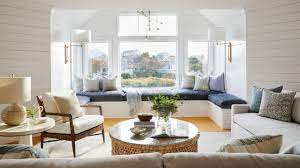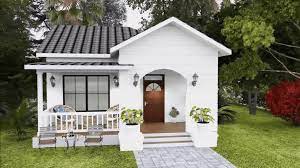The Art of New Home Design
Designing a new home is an exciting journey that allows homeowners to create a space that reflects their personality and lifestyle. With the right approach, new home design can transform a house into a sanctuary that is both functional and aesthetically pleasing.
Key Elements of New Home Design
When embarking on the design process for a new home, it’s essential to consider key elements that will shape the overall look and feel of the space:
- Layout: The layout of a home plays a crucial role in how spaces flow and interact with each other. Open floor plans are popular for creating a sense of spaciousness and connectivity.
- Color Scheme: Choosing the right color palette can set the tone for the entire home. From calming neutrals to bold accents, colors can evoke different moods and emotions.
- Furniture and Decor: Selecting furniture pieces and decor items that complement each other is key to achieving a cohesive look. Mixing textures, patterns, and styles can add visual interest.
- Lighting: Proper lighting can enhance the ambiance of a home. Natural light, overhead fixtures, task lighting, and accent lighting all play a role in illuminating different areas.
- Multifunctional Spaces: In modern home design, versatility is key. Creating multifunctional spaces that serve multiple purposes can maximize efficiency and utility.
Trends in New Home Design
New home design trends evolve with time, reflecting changes in lifestyle preferences and technological advancements:
- Sustainable Design: Eco-friendly materials and energy-efficient features are increasingly incorporated into new homes to reduce environmental impact.
- Smart Home Technology: Integration of smart devices for automation, security, and convenience is becoming more prevalent in modern homes.
- Outdoor Living Spaces: Emphasis on outdoor areas such as patios, decks, and gardens allows homeowners to extend their living space beyond the confines of the house.
- Mixed Materials: Mixing different materials like wood, metal, glass, and stone adds depth and character to new home designs.
- Minimalist Aesthetics: Clean lines, uncluttered spaces, and minimalistic decor are popular choices for those seeking simplicity and tranquility in their homes.
In conclusion, new home design is an art form that blends creativity with functionality to create spaces that resonate with individuals on a personal level. By paying attention to key elements and staying abreast of current trends, homeowners can craft homes that are not just living spaces but reflections of their unique identities.
7 Benefits of New Home Design: From Customization to Enhanced Resale Value
- 1. Customization
- 2. Energy Efficiency
- 3. Modern Amenities
- 4. Warranty Coverage
- 5. Low Maintenance
- 6. Safety Standards
- 7. Resale Value
Challenges of Modern Home Design: Balancing Cost, Trends, and Practicality
- Costly upfront investment for custom designs and high-end materials.
- Trends may quickly become outdated, requiring frequent updates to maintain a modern look.
- Limited flexibility in making structural changes once the design is finalized.
- Design choices may not always align with practical needs or lifestyle preferences of occupants.
- Complexity of coordinating various design elements can lead to decision fatigue and potential inconsistencies in the overall aesthetic.
1. Customization
New home design offers the invaluable advantage of customization, enabling homeowners to tailor their living spaces to align perfectly with their unique preferences and lifestyle requirements. From selecting layout configurations that optimize functionality to choosing color schemes and decor elements that resonate with personal style, the ability to customize a new home ensures that every aspect of the living environment reflects the individuality and specific needs of its occupants. This level of personalization not only enhances comfort and satisfaction but also fosters a sense of ownership and connection to the space, making it truly one’s own sanctuary.
2. Energy Efficiency
Energy efficiency is a significant advantage of new home design. By integrating modern technologies and sustainable features into the construction process, homeowners can enjoy the benefits of energy-efficient homes that not only help reduce their environmental footprint but also lead to lower utility costs in the long run. From efficient insulation to energy-saving appliances and smart home systems, incorporating these elements into new home designs can create a more sustainable living environment while saving money on energy bills.
3. Modern Amenities
One of the significant advantages of new home design is the integration of modern amenities. Today’s new home designs frequently feature state-of-the-art amenities, including smart home systems, high-end appliances, and luxury finishes. These modern conveniences not only enhance the functionality and efficiency of the home but also elevate the overall living experience for homeowners. With a focus on incorporating cutting-edge technology and luxurious touches, new homes offer residents a lifestyle that is both comfortable and sophisticated.
4. Warranty Coverage
One significant advantage of new home design is the inclusion of warranty coverage. When purchasing a new home, buyers often benefit from warranties that offer protection against structural defects or malfunctions in appliances. This added assurance provides homeowners with peace of mind, knowing that any unforeseen issues that may arise post-construction are covered under the warranty. Warranty coverage adds an extra layer of security and ensures that homeowners can enjoy their new living space without the worry of potential costly repairs.
5. Low Maintenance
One significant advantage of new home design is its low maintenance requirement. In comparison to older homes, new constructions generally demand less upkeep, resulting in time and cost savings over the long term. This benefit allows homeowners to enjoy a more hassle-free living experience and allocate their resources towards other priorities, knowing that their new home is designed to be efficient and durable with minimal maintenance needs.
6. Safety Standards
One significant advantage of new home design is the adherence to safety standards. New homes are constructed in compliance with current safety codes and regulations, guaranteeing a secure living environment for residents. By prioritizing safety in the design and construction process, homeowners can have peace of mind knowing that their new home provides a safe and protected space for themselves and their loved ones.
7. Resale Value
One significant advantage of new home design is its positive impact on resale value. Well-designed new homes have the potential to maintain their value over time, making them a sound investment choice for homeowners. By focusing on quality design elements and incorporating modern features, new homes are more likely to attract buyers and command a higher selling price in the real estate market. This aspect of new home design ensures that homeowners can enjoy a good return on their investment when it comes time to sell the property.
Costly upfront investment for custom designs and high-end materials.
One significant drawback of new home design is the substantial upfront investment required for custom designs and high-end materials. Opting for personalized architectural plans and premium finishes can significantly increase the overall cost of building a new home. From hiring specialized architects to sourcing top-quality materials, the expenses can quickly add up, making custom design options financially prohibitive for some homeowners. While these investments may result in a unique and luxurious living space, the initial financial burden can pose a challenge for those with budget constraints or limited resources.
Trends may quickly become outdated, requiring frequent updates to maintain a modern look.
One significant drawback of new home design trends is the risk of quick obsolescence, leading to the need for frequent updates to uphold a modern aesthetic. What may be considered stylish and contemporary today could easily become outdated tomorrow, necessitating homeowners to invest time and resources into keeping up with ever-changing design fads. This constant cycle of updates can be both financially burdensome and time-consuming, challenging individuals to strike a balance between staying current and maintaining a timeless appeal in their living spaces.
Limited flexibility in making structural changes once the design is finalized.
One significant drawback of new home design is the limited flexibility in making structural changes once the design is finalized. Once the architectural plans are set and construction begins, altering the layout or structure of a new home can be challenging and costly. This lack of adaptability can restrict homeowners from accommodating future needs or preferences, leading to potential dissatisfaction with the living space over time. It underscores the importance of careful planning and consideration during the initial design phase to ensure that the home meets both current and future requirements without compromising on functionality or aesthetics.
Design choices may not always align with practical needs or lifestyle preferences of occupants.
In the realm of new home design, a significant drawback lies in the possibility that design choices may not always align with the practical needs or lifestyle preferences of occupants. While aesthetics and trends play a crucial role in shaping the visual appeal of a home, overlooking the functional aspects can lead to dissatisfaction and inconvenience for those living in the space. It is essential for designers and homeowners to strike a balance between style and usability to ensure that the design not only looks good but also serves its intended purpose effectively, enhancing the overall quality of life for its inhabitants.
Complexity of coordinating various design elements can lead to decision fatigue and potential inconsistencies in the overall aesthetic.
The complexity of coordinating various design elements in new home design can present a significant challenge, often leading to decision fatigue and potential inconsistencies in the overall aesthetic. With numerous choices to make regarding layout, color schemes, furniture, decor, lighting, and more, homeowners may feel overwhelmed by the sheer volume of decisions involved. This can result in hasty choices or conflicting design elements that detract from the cohesive look and feel of the home. Careful planning and attention to detail are essential to navigate this con effectively and ensure a harmonious and well-coordinated design outcome.




